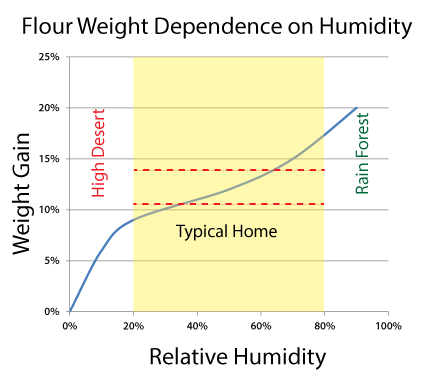| g e n u i n e i d e a s | ||||||
 |
 |
 |
 |
 |
 |
 |
| home | art and science |
writings | biography | food | inventions | search |
| heavy water |
|
April 2014
Your grandmother probably baked by touch- following an oral tradition ingrained through years of repetition. No written recipes. No measured ingredients, except by eye. Today, families live a continent apart and seek variety in their meals. So precise measurements, prescriptive recipes and food TV replaces a kitchen stuffed full with grandmas. But can you trust these recipes? By now, most bakers understand volume measurements of flour in recipes are notoriously unreliable. Depending on the flour's grind and how hard you tamp it into a cup, its weight can vary by a factor of two. Which is the difference between a soggy lump of dough and a crispy baguette. A kitchen scale is your best friend- especially when a grandmother is unavailable. Yet countless recipes also darkly assert that weight itself may be an equally unreliable guide, due to flour absorbing or losing moisture to water from the air. Hard to imagine this humidity effect is as large the factor-of-two between weighing flour and a measuring cup, but let's experiment and find out. The first test is "quick and dirty"-- just simple enough to get a rough handle on the possibilities. I took 100 gms of flour from the pantry (stored in a 33% relative humidity (RH) environment), and warmed it in a 165F oven for 6 hours. A small motor and vane agitated the flour so it would quickly dry out. At the end of the 6 hours it had lost 8% in weight. No one's flour is drier than this.... If we assume most recipes call for roughly equal amounts of water to flour, this shifts the fraction of water in dough from 50% (for bone-dry flour) to 55% (for standard pantry flour, containing 8% more available moisture). Is this significant? Perhaps. Some baking recipes are written in terms of 240 gms of water, rather than 250 gms, or (yech) 1 cup plus 1 teaspoon water, instead of 1 cup exactly. In other words, a few percent control over the water content ostensibly matters. I find this precision suspicious on its face - if you determine volumes with a measuring cup, 2% resolution is limited by the meniscus distorting the printed line on the cup. Which is more than a tsp in error. A good digital scale is accurate to 1-2%, so a few percent weight difference can be detected, but still, humidity doesn't feel like the smoking gun of bread baking. In the absence of a grandmother, perhaps the recipe's author is trying to communicate a particular dough consistency with these annoyingly precise numbers. Or perhaps it is an artifact of converting from cups to grams. But, just in case the stray tsp of absorbed water matters, let's look at a broader range of storage humidities. I measured weight gain at five different humidity1 levels. Flour was placed in a shallow bowl in a chamber with controlled humidity, confirmed with a digital sensor. Again, a motorized blade agitated the flour to speed up exposure to the air. I also combed the literature2 for similar experiments, and my results are in rough agreement with their data. This plot is a simplified blend of my results and the literature. Typical homes and environments are contained within the yellow area below. Note the fastest changes in weight are at the extreme limits of humidity. Flour is hygroscopic, and quickly scavenges any available humidity from its environment:
So my initial "quick and dirty" test overestimated the humidity offset in flour weight. By the time you store flour in a 'typical home" with humidity above 20%, most of the rapid moisture absorption has occurred. Additional variation during the year, from humid summers to dry winters, probably changes the weight by a mere +1%. You can also store the flour in a tightly sealed container in the freezer. Even in an open container I have measured no weight loss after 2 months. And the cold will reduce spoilage. The dotted lines indicate USDA weight guard bands. The upper dotted line is at the expected (13.5%) water content in freshly manufactured flour. The lower dotted line is a 3% reduction from this value- a so-called "gray area" of allowable weight shortfall due to evaporation for products like flour, pasta, dry dog food, etc. The band nicely overlaps typical weight changes in typical homes. So we have learned:
|
|
-------------------------------------------------------------------------------------------------------- 1 Saturated salt solutions are a convenient way to precisely control humidity levels -- see this table for details. 2 For example, this presentation on humidity in pasta, or this study on durum flour. Most papers report weight gain as a function of "water activity", rather than the more familiar relative humidity. I've made a rough conversion to equilibrium RH for simplicity and ease of explanation, and glossed over the difference between free and bound water. For example, the baseline for water content is measured by drying at 130C (266F), but homes never get this hot, so I dried at only 74C (165F). Instead of measuring 14% water weight, I removed 8% by drying. 3 Even in July, relative humidity is bookended between 20% and 80% across the continental US. And this chart measures outside humidity levels- while most homes are air-conditioned. So your flour is likely stored in the "typical" band above, and you don't have to take humidity into account when weighing.
|
 Contact Greg Blonder by email here - Modified Genuine Ideas, LLC. |


